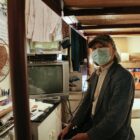John Britt, 59, couldn’t fathom where the dust was coming from. Like snow, the pale powder descended on his belongings. It settled on the coffee table, the entertainment stand and the blinds. He dusted his SoMa studio apartment twice a week in futile attempts to keep it clean.
The constant dust upset him. It also triggered his asthma, which he has had since he was a kid.
“It’s hard to breathe,” he said. “But I haven’t really been feeling like that for the last month, basically since I got the air purifier.”
Britt was one of 50 low-income tenants to receive free air purifiers through a government-funded pilot program in July and August, the result of efforts by local organizations to cut red tape and make it easier to distribute the devices. Most recipients have respiratory conditions and live in single-room occupancy hotels, commonly called SROs. The initiative aims to ameliorate and help prevent health problems — early results are promising — and if enough people benefit then the government could keep funding the work, putting more devices in the hands of tenants who need them.
Sign up for our free weekly newsletter for local journalism on environmental issues.
For Britt, the purifier is welcome relief in his home at the Clementina Towers, a building run by the Tenderloin Neighborhood Development Corporation for low-income and disabled seniors.
“TNDC is pleased that Mr. Britt has been able to take advantage of the air purifier distribution program and that its use has helped ease his asthma,” said Edmund Campos, senior communications manager for the Tenderloin Neighborhood Development Corporation, in an emailed statement. He added that Britt had never reported excessive dust to the property manager, which Britt confirmed.
Structural causes of bad air
Britt’s portable air purifier cost about $100, which is out of reach for many SRO tenants. A 2021 Brightline Defense survey found that only about 18% of SRO residents could afford one.
But they might be the San Franciscans who most need the devices. Adults living in SROs face asthma hospitalization rates that are twice the citywide average, and chronic obstructive pulmonary disease rates that are three times higher, according to a 2017 Department of Public Health report.
That’s due in large part to the aging structures they live in. SRO buildings tend to be old, poorly maintained and lack modern heating and air conditioning systems, as well as effective ventilation. When tenants shower, humidity can build up and cause toxic black mold to grow. If unaddressed, the mold penetrates the surrounding wood and becomes a long-term problem.
Airborne pollutants from cat litter, candles and gas stoves can all accumulate indoors. Some tenants smoke methamphetamine and fentanyl in their rooms, and the exhaled, harmful chemicals linger in the air, said Sheyenne White, a community organizer with the Central City SRO Collaborative.
SRO buildings are concentrated in the Tenderloin and other downtown areas that are dense with vehicles, which give off exhaust. Often, an SRO unit has a single window that opens to the street or is right above a ground-floor restaurant’s kitchen, which can produce smoke from cooking. Tenants face a difficult choice: Keep the window closed and let the indoor air fester, or open it and let other pollutants in.
In a way, the choice is easier during hotter seasons — though the health consequences remain. SRO tenants throughout the Tenderloin have to open their windows to find relief, and their sills gradually blacken with soot, said Stephen Tennis, another organizer with the collaborative.
“Otherwise they would roast,” Tennis said.
Red tape hampered aid
Tennis and other members of the collaborative, as well as staff at local nonprofit La Voz Latina, are working with environmental justice organization Brightline Defense to carry out the pilot program.
The groups have spent years trying to put air filtration devices in tenants’ hands. At first, the work suffered from bureaucratic hurdles, said Carolina Correa, air quality program manager at Brightline Defense.
Government funding paid for the purifiers but, to be eligible, recipients needed to attend two video interviews and obtain notes from doctors attesting to their respiratory conditions. Many people were too poor to seek regular medical care, so they didn’t have diagnoses. Others had limited physical mobility or no access to a car, so they couldn’t easily visit their doctors in person.
“It was a major barrier to get the paperwork in order,” said Peter Rauch, a tenant organizer at the collaborative. “It discouraged a lot of people and they didn’t follow through.”
In 2021, roughly half the residents Brightline Defense helped apply for air purifiers ultimately did not receive one because they couldn’t meet the requirements, Correa said.
Members of the collaborative pushed to cut the red tape. In July 2023, a half-dozen tenant organizers made their case at the headquarters of the Bay Area Air Quality Management District, the regional government agency responsible for regulating air pollution and the funder of the air purifiers. The organizers persuaded the agency to test what would happen if it loosened requirements.
For that pilot project, which began in October 2023, the organizers personally scoured the government-subsidized housing community to identify the best potential recipients. In their outreach, they prioritized people who said they had respiratory conditions, even if they lacked documentation. And to make things even easier, organizers had participants fill out just one survey about the purifiers’ impacts on air quality, rather than the two previously required.
“It just made it much easier to get purifiers to people who need it, and that to me is the most important thing,” Tennis said.
Finding relief
Early surveys show that the purifiers are working. When asked to rate their homes’ air quality on a scale of one to 10, people who rated it “3-4” before receiving the devices are now rating it “8-10,” Rauch said. Residents report that they are coughing less, sleeping better and are less winded when walking up and down stairs, White said. People have noticed less soot in their rooms and that their allergies have subsided, added Correa of Brightline Defense.
Once all surveys are completed, the results will inform the Bay Area Air Quality Management District’s decision on whether to continue funding the pilot program next year.
The air purifiers are a crucial mitigation tool, but they don’t address the underlying causes of air pollution. To do that, big policy changes are needed, including widespread retrofits of San Francisco buildings, said Jacob Linde, Brightline Defense’s air quality organizer. The renovations, which local groups are trying in multi-unit apartment buildings, would help ventilate SRO buildings while reducing their carbon footprints, he said.
Back in his SoMa studio, Britt no longer has to wage war against the dust in his apartment. He runs his air purifier 24 hours a day. His asthma symptoms feel milder. He only has to dust once a week now.
Those small wins are deeply gratifying to Rauch, who wants his neighbors to be able to breathe safely in their homes.
“Air is as precious as water. It’s what we humans rely on,” Rauch said.










